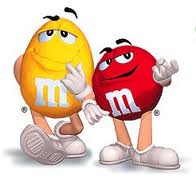Conclusion

Proportion Tests (each one compares the true proportion of two different colors in a bag)
In our first test, we wanted to determine whether the true proportion of blue M&Ms per bag was greater than the true proportion of orange M&Ms per bag. Using a two-proportion z-test, we received a p-value of 0.534. Since the p-value was greater than alpha, we failed to reject the null hypothesis at the 0.05 level of significance. Therefore, we do not have sufficient evidence to conclude that the true proportion of blue M&Ms is significantly greater than the true proportion of orange M&Ms per bag.
Our second test was to determine whether the true proportion of red M&Ms per bag was less than the true proportion of blue M&Ms per bag. We ran a two-proportion z-test and received a p-value of 0.000. Since the p-value is less than alpha, we rejected the null hypothesis at all levels of significance. Therefore, we do have sufficient evidence to conclude that the true proportion of red M&Ms is significantly less than the true proportion of blue M&Ms per bag.
In our third test, we wanted to determine whether the true proportion of green M&Ms per bag was different than the true proportion of brown M&Ms per bag. Using a two-proportion z-test, we received a p-value of 0.000. Since the p-value was less than alpha, we rejected the null hypothesis at all levels of significance. Therefore, we do have sufficient evidence to conclude that the true proportion of green M&Ms is significantly different than the true proportion of brown M&Ms per bag.

